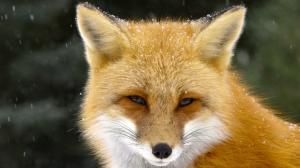Program description courtesy of PBS.org.
The PBS Nature program aired an episode on Red Foxes, October 16, 2017. Fox Tales: The Red Fox: A Rare Look Into The Life of One of the Most Widespread and Adaptable Mammals on the Planet revealed the intelligence, resilience and boldness of the Red Fox: , which can change its behavior to thrive in a variety of environments, from urban locales to the Arctic tundra.
To get the amazing close-up film footage of these sometimes elusive creatures, filmmakers used motion sensors and remote control camera rigs.
These adaptable and intelligent canids can make their home along the cliffs of Newfoundland and the Arctic tundra. Over the last century, they have also been slowly populating urban centers. According to Wildlife Specialist Dr. David Drake of the University of Wisconsin-Madison, “There’s not a lot of urban Red Fox research going on in North America…But I would be very, very surprised if there are not Red Foxes in most, if not, all North American cities.”
Motion-sensitive, infrared cameras capture the behavior of newborn pups and their mother in a natal den during the first weeks after birth. Animal Behaviorist Dr. Sandra Alvarez-Betancourt of the University of Bristol, who has analyzed thousands of hours of fox behavior underground, explains that as soon as Red Fox pups can walk, they start vying to establish their social hierarchy.
Along the Newfoundland coast, the program tracks a Red Fox family over a six month period as they raise their young pups and teach them all the skills they need to survive on their own in the wild.
In the Arctic tundra, an increasing number of Red Foxes are expanding their reach into Arctic Fox territory. Biologist Dr. James Roth of the University of Manitoba says that Red Foxes are using more and more of the Arctic Fox dens and have been known to kill Arctic Foxes. Dr. Roth says it is another example of how these smart Red Foxes can exploit a new territory and survive anywhere in the world.
And what about Red Foxes moving into urban centers? In the film, Dr. Drake notes that one of the surprising findings was just how compatible urban canids seem to be with people, given that many are living in backyards, under decks, etc. They can maintain a natural diet of small mammals and other available food, so they tend to be a bit heavier. Drake and his team have also been monitoring how Red Foxes and coyotes are moving through Madison.
But in Bristol, the story is different. Rather than hunt for small mammals, about 70 to 80 percent of the Red Foxes’ diet is provided by local homeowners who do not see them as a threat. Biologist Dr. Stephen Harris of the University of Bristol attributes this attitude to the fact that, in Great Britain, Red Foxes do not have rabies and there aren’t many other diseases that animals might convey. No matter where they make their home, Red Foxes have showed they are one of the most widespread and adaptable mammals on the planet.
Photo courtesy of CBC/Canada
The PBS Nature program aired an episode on Red Foxes, October 16, 2017. Fox Tales: The Red Fox: A Rare Look Into The Life of One of the Most Widespread and Adaptable Mammals on the Planet revealed the intelligence, resilience and boldness of the Red Fox: , which can change its behavior to thrive in a variety of environments, from urban locales to the Arctic tundra.
To get the amazing close-up film footage of these sometimes elusive creatures, filmmakers used motion sensors and remote control camera rigs.
These adaptable and intelligent canids can make their home along the cliffs of Newfoundland and the Arctic tundra. Over the last century, they have also been slowly populating urban centers. According to Wildlife Specialist Dr. David Drake of the University of Wisconsin-Madison, “There’s not a lot of urban Red Fox research going on in North America…But I would be very, very surprised if there are not Red Foxes in most, if not, all North American cities.”
Motion-sensitive, infrared cameras capture the behavior of newborn pups and their mother in a natal den during the first weeks after birth. Animal Behaviorist Dr. Sandra Alvarez-Betancourt of the University of Bristol, who has analyzed thousands of hours of fox behavior underground, explains that as soon as Red Fox pups can walk, they start vying to establish their social hierarchy.
Along the Newfoundland coast, the program tracks a Red Fox family over a six month period as they raise their young pups and teach them all the skills they need to survive on their own in the wild.
In the Arctic tundra, an increasing number of Red Foxes are expanding their reach into Arctic Fox territory. Biologist Dr. James Roth of the University of Manitoba says that Red Foxes are using more and more of the Arctic Fox dens and have been known to kill Arctic Foxes. Dr. Roth says it is another example of how these smart Red Foxes can exploit a new territory and survive anywhere in the world.
And what about Red Foxes moving into urban centers? In the film, Dr. Drake notes that one of the surprising findings was just how compatible urban canids seem to be with people, given that many are living in backyards, under decks, etc. They can maintain a natural diet of small mammals and other available food, so they tend to be a bit heavier. Drake and his team have also been monitoring how Red Foxes and coyotes are moving through Madison.
But in Bristol, the story is different. Rather than hunt for small mammals, about 70 to 80 percent of the Red Foxes’ diet is provided by local homeowners who do not see them as a threat. Biologist Dr. Stephen Harris of the University of Bristol attributes this attitude to the fact that, in Great Britain, Red Foxes do not have rabies and there aren’t many other diseases that animals might convey. No matter where they make their home, Red Foxes have showed they are one of the most widespread and adaptable mammals on the planet.
Photo courtesy of CBC/Canada







